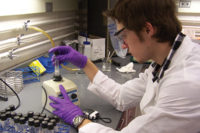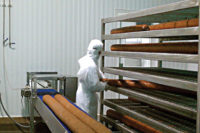Several large-scale recalls have been issued recently for products containing foreign material, which creates headlines that draw a lot of attention to how the industry keeps foreign material from contaminating the food supply. We’ve heard rumblings of new government policies, so it is prudent to review the basic concerns. I believe it is safe to say that all parties — consumer, regulator or protein manufacturer — do not want foreign material in food.
If you step back and recognize the sheer scale of our food supply and the industry, you would be astounded at how well we actually control this. Yet, regardless of the progressive steps we have taken, there are still changes to be made in order for us to manage the risk.
Today, it takes only a few small events to lead to a significant problem. The reality is, our industry is not capable of a zero-tolerance program in terms of foreign material making its way into the product stream, and we must continue to push ourselves to manage the challenges. The key to our approach is prevention and risk mitigation. If we are able to remove the risk, we do so; if not, we try to control it. The industry has adopted many different approaches to managing risks.
Regardless of what we do, the manufacture and distribution of food involves a lot of equipment, conveyors, pallets, containers, plastic covers and corrugated boxes. All of these items must be adequately managed to prevent foreign material from entering the product stream.
Processes that work
The use of metal detectors has been universally employed throughout the food industry for years. Metal detection does a satisfactory job, but unfortunately it is not foolproof and therefore must be managed. For example, many systems have a reject mechanism that will identify and remove suspect product from a conveyor belt. This system must accurately contain suspect product, so the management and investigation of a potential metal source must be understood quickly and accurately. Another challenge arises when differences in temperature are sensed and cause misreadings. This, in turn, causes large amounts of product to accumulate quickly. Therefore, temperature-related misreadings must be managed and controlled to make sure product doesn’t inadvertently move further down the line.
X-ray technology is a fantastic improvement in foreign-material detection to visual inspection; however, it is also not without challenges. The use of X-ray requires calibration to the foreign material that is being searched for, so it is difficult to use routinely unless you already know of a concern or consistent foreign-material issue. In the case of bone detection, it is a superior tool and has improved the safety of many operations, especially in its use for poultry. It can also be used for metal detection.
Challenging materials
Hard plastic and other non-metallic material remain a nemesis for quality-assurance departments. The cleanability of Delron, which is an acetal polyoxymethylene resin approved by the FDA, and other materials have improved the food safety of our industry significantly. However, if they are damaged and enter the product stream, these materials will cause severe problems. With long conveying systems, it can be difficult to identify broken or damaged sections, but the quicker it is observed, the less product is affected. Therefore, a good belt integrity management program is essential for management of risk and identifying opportunities quickly.
Wood is another challenge for our industry, as nearly every raw material arrives on wood pallets. Some pallets are in better shape than others, but this is another identified risk that must be controlled. West Liberty Foods has made a significant push to remove the use of wood pallets and combo bins that use corrugate and plastic. We have replaced these materials with hard plastic combo bins.
This may cause you to stop and scratch your head, saying, “Aren’t you simply moving from one high-risk material to another?” The answer is yes, but we have seen beneficial results with specific types of plastic combos and have employed a program to manage the upkeep of the plastic. We have had great long-term success with their use.
Any time you work with raw meat and see it through the processes of grinding, macerating, mixing etc., you will ultimately need to transfer it into a container of some kind. We have learned the hard way this action must be carefully performed. Combos must be carefully wrapped to control the inadvertent piece of wood or torn liner from contaminating the product. This step is crucial, as any problems in the grinding step will be exacerbated further downstream.
Prevent or contain
Speaking briefly on foreign-material programs, I believe an essential component to a successful foreign-material program is two-fold. The first and most important is prevention, and many of the programs discussed previously are designed to minimize the risk of contamination. The second is to identify the problem and find ways to contain it. An essential piece of the program is having a thorough process for tracking and receiving complaints — which involves a thorough incident investigation and an appropriate response.
As we look forward to our future, and as our industry continues to evolve, better technology will aid us substantially. Until then, we must continue to improve our processes and be transparent to regulators so they can understand the challenges our industry faces when drafting rules and regulations. NP




Report Abusive Comment